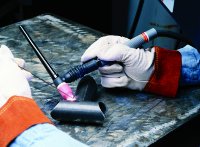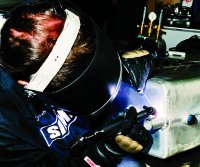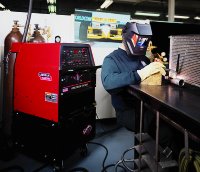Micro Start TIG Technology
When it comes to welding processes, TIG is one of the most demanding. Creating a high-quality TIG weld requires good, consistent starting performance and arc stability even at low amperages. This can be challenging for even the most skilled welder, especially with a conventional TIG power source – But now with Lincoln Electric’s Micro-Start Technology™ there is nothing standing between the operator and a good weld.
The innovative Micro-Start TIG technology was developed with the user in mind. Numerous interviews were conducted with TIG operators – from those with an advanced skill level to the beginner. Lincoln asked these welding operators about their most common problems and set out to provide a technological advantage that would overcome those problems. What resulted was the Precision TIG™ with its Micro-Start TIG technology. This machine will help any TIG operator create their best possible weld – time and time again. Among SCR TIG machines, Micro-Start produces best-in-class DC welding.
Having a technology that addresses TIG welding problems is of critical importance today as more and more manufacturers are turning to new materials and exotic alloys that are thinner and in many cases, harder to weld. Any industry that welds thin materials, including aerospace and marine, can take advantage of Micro-Start TIG to provide precise control and top quality welds.
So what are these common problems that Lincoln’s Micro-Start TIG technology overcomes? Basically, they fall into four categories: 1) low-end performance; 2) low-end starting; 3) minimum starting amperages; and 4) crater fill.
Problem: Poor Low-End Performance
In many traditional, low amperage TIG applications operators have trouble maintaining a smooth, stable arc. When using a SCR (silicon controlled rectifier) machine to weld at low amperages, the SCR conductions in the machine are "phased back" to very short duration spikes of output. This results in a great deal of ripple in the output current as these minimal firings produce gaps between the spikes of current. Even with the normal output choke filtering, the choke cannot store enough energy between SCR firings to stabilize the arc. This ripple effect leads to arc instability and sporatic, high-frequency re-initiations, thus leading to inconsistency in the welds.

Trying to correct this problem, many operators traditionally purchased more expensive, conventional TIG machines. They believe these machines with larger chokes will better filter the arc current to produce more stability and better low end welding performance. But even the larger choke cannot adequately filter out the low current ripple.
The Micro-Start TIG Solution
Micro-Start TIG technology employs an independent power supply capable of welding without SCR assistance at low amperages – SCRs only fire to raise the current and supplement the 2 amp welding supply. This gives Micro-Start TIG very stable low current welding and provides it with the ability to eliminate erratic high frequency and weld thin materials in a consistent, high quality manner. Lincoln is the first manufacturer to offer a background circuit from which an operator can weld and smoothly transition to, or from, higher outputs.
Micro-Start TIG is capable of independently welding off of its electronic power supply when the amperage is down to the minimum rated 2 amps. As the operator depresses the foot Amptrol™ to increase the current, the main welding circuit (i.e. transformer and SCR bridge) turns on and provides amperage. The technology assists the transformer SCR choke circuit with its special electronic welding circuit instead of completely relying on chokes to smooth the arc as do conventional machines. The result is a very stable and smooth output at low amperage levels.
With Micro-Start TIG, operators don’t have to buy more expensive machines to get low end welding capabilities – Micro-Start technology is able to provide inverter-like performance using a lower cost, conventional machine.
Problem: Low-End Starting
Today’s TIG machines establish an arc by using high frequency to ionize a path from the tungsten to the workpiece. Though high frequency is necessary to establish the arc, in most machines it remains on for a long duration and with a high intensity, thus creating “tracking” marks on the weld surface. For critical welding applications such as aerospace or nuclear qualified welds, these tracking marks can cause micro-cracking and lead to weld imperfections. Even in non-critical applications, high frequency can create starting with a great deal of objectionable arc wander.
Another problem with conventional machines is that they can’t start at very low current (typically below 5 amps). This is because at the minimal firing of the SCRs, the output choke cannot store enough energy to maintain the current at a welding voltage to initiate and sustain the arc without re-initiating high frequency.
To improve starting, many competitive TIG machines use a Hot Start feature. Hot Start utilizes SCR conduction spikes of high current at sufficient voltage and duration to heat the tungsten and establish an ion path quickly from the tungsten to the work piece in order to reduce duration of high frequency. For example, if the operator sets the machine for 5 amps, the machine may spike up over 100 amps for a significant period of time during starting. But this method is too problematic because on thin material, a Hot Start will erode the workpiece and burn away the base metal. Some operators have even resorted to starting on copper blocks or welding coupons before moving the arc onto the weldment to combat negative effects of high frequency and hot-starting. This method allows time for the arc to stabilize and prevents damaging the workpiece.
Operators may often manually “Hot Start” by pushing down the TIG machine’s foot pedal to a higher starting amperage. But with this approach, the machine never starts at a low enough amperage resulting in potential burn-through or erosion of the welded work piece. It also does not produce consistency since operators have to “guess” where to start.
The Micro-Start TIG Solution
With Micro-Start TIG technology, Lincoln Electric has devised a way to get the arc established quicker, smoother and with more stability using the electronic 2 amp welding power supply to supplement a SCR starting pulse height and duration appropriate for the welding level. An improved control circuit lets this new technology utilize a shorter, less intense pulse ignition to light the arc without “popping” or creating “burnthough”, thus allowing the high frequency to turn off virtually when the arc first strikes.
In fact, most users can’t even detect that the high frequency is on. This quick start is short and will not allow enough heat input to burn any material away. But the start offers enough energy to heat the tungsten and establish a plasma flow to the work piece.
Micro-Start TIG also allows operators to adjust the minimum amperage of the machine. This allows the operator to adjust the low end of the machine to match the specific operating amperage range for the tungsten diameter being used, as well as his or her own low current skill level.
Problem: Minimum Starting Amperages
Most conventional machines allow operators to set only the maximum amperage, but will not allow for a minimum to be set. This means that if a tungsten and/or operator cannot start at the minimum output of the machine, than the foot pedal control must be “punched” to a higher level to achieve a start. This makes it difficult to achieve consistent starting, as well as repeatable crater filling.
Micro-Start TIG Solution
Lincoln offers the only machine with a minimum output control which lets the operator adjust the minimum amperage of the machine at minimum foot pedal depression to match the tungsten operating range or operator skill level. For example, if the operator is using a 3/32 diameter tungsten, its typical operating range is 10 to 150 amps. The operator can now set the minimum amperage of the machine not to go below 10 amps at foot pedal minimum to promote stability in welding and starting. Likewise for someone using a .020 or .040 tungsten – the minimum amperage can be turned down to 2 amps since this tungsten can run stable in this range. This minimum output control allows independent preset of minimum current level between 2 and 60 amps. This provides an optimum resolution range for remote control (foot pedal) between the minimum and maximum preset settings.
Problem: Crater Fill
One of the most frequent complaints conventional TIG operators voiced was the problem associated with lowering the current to fill a crater at the end of the weld. Traditional machines use a current sensing threshold approach, which means that when the operator ramps down and the arc becomes unstable, the machine detects the arc is in danger of extinguishing and initiates the high frequency again. With the current threshold method, the high frequency comes on at typically about 3 amps. The high frequency coming back on creates a wandering or “dancing” arc that leaves track marks on the weld allowing for contamination, microscopic cracking and surface imperfections.
Micro-Start TIG Solution
Lincoln’s Micro-Start TIG technology uses a voltage sensing method. This is a more “intelligent” sensing method that knows whether the operator is trying to maintain an arc. High frequency will only come back on if the sensed output voltage is greater than 35v (well above normal welding voltage). Therefore, the machine will provide a low current ramp down during cratering without unintended high frequency. In other words, during welding high frequency will not come back on again after the start of the sequence.
Traditionally, power sources are not sophisticated enough to sense whether or not an operator is actually welding – and when the operator wants to weld at low amperages. With Micro-Start TIG technology, once the high frequency initiates the DC arc, high frequency is no longer needed because of the low amperage stability of the background circuit.
Conclusion
With Lincoln’s Micro-Start TIG technology, an operator at virtually any TIG skill level will be able to make repeatable, high-quality starts, welds and finishes. This is because the new technology makes it easy to overcome the most common TIG welding issues with machines that overcome the most common performance limitations.



